Serving 477 students in grades Prekindergarten-5, P.s. 110 Monitor ranks in the top 50% of all schools in New York for overall test scores (math proficiency is top 50%, and reading proficiency is top 50%).
The percentage of students achieving proficiency in math is 45-49% (which is approximately equal to the New York state average of 46%). The percentage of students achieving proficiency in reading/language arts is 55-59% (which is higher than the New York state average of 49%).
The student:teacher ratio of 16:1 is higher than the New York state level of 11:1.
Minority enrollment is 36% of the student body (majority Hispanic), which is lower than the New York state average of 60% (majority Hispanic).
Quick Stats (2025)
- Grades: Prekindergarten-5
- Enrollment: 477 students
- Student:Teacher Ratio: 16:1
- Minority Enrollment: 36%
- Overall Testing Rank: Top 50% in NY
- Math Proficiency: 45-49% (Top 50%)
- Reading Proficiency: 55-59% (Top 50%)
- Science Proficiency: ≥90% (Top 30%)
- Source: National Center for Education Statistics (NCES), NY Dept. of Education
School Overview
P.s. 110 Monitor's student population of 477 students has declined by 14% over five school years.
The teacher population of 29 teachers has declined by 12% over five school years.
Grades Offered
Grades Prekindergarten-5
(offers virtual instruction)
(offers virtual instruction)
Total Students
477 students

Gender %
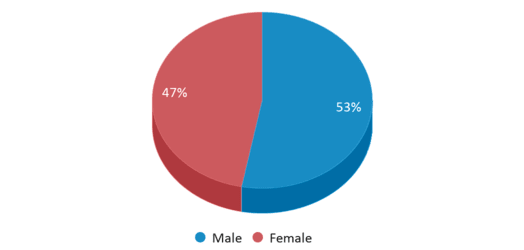
Total Classroom Teachers
29 teachers
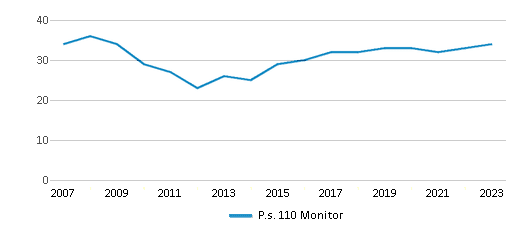
Students by Grade
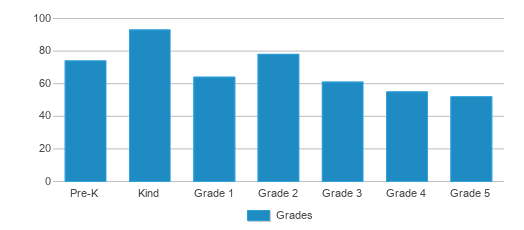
School Rankings
P.s. 110 Monitor ranks within the top 50% of all 4,377 schools in New York (based off of combined math and reading proficiency testing data).
The diversity score of P.s. 110 Monitor is 0.54, which is less than the diversity score at state average of 0.72. The school's diversity has stayed relatively flat over five school years.
Overall Testing Rank
#1642 out of 4377 schools
(Top 50%)
(Top 50%)

Math Test Scores (% Proficient)
45-49%
46%
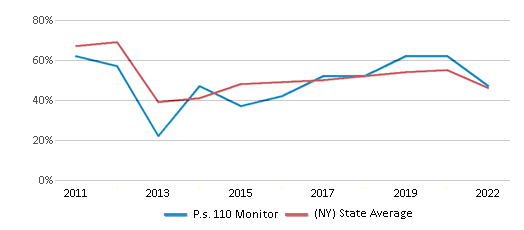
Reading/Language Arts Test Scores (% Proficient)
55-59%
49%
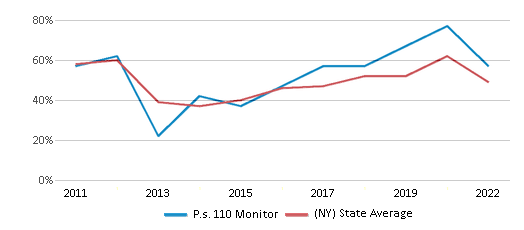
Science Test Scores (% Proficient)
≥90%
78%
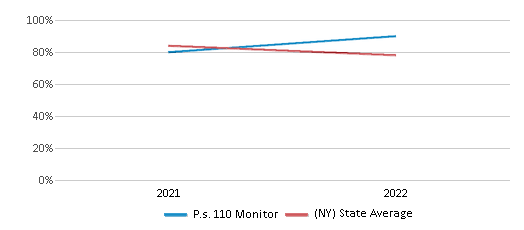
Student : Teacher Ratio
16:1
11:1
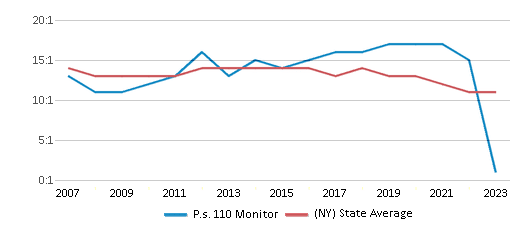
American Indian
n/a
1%
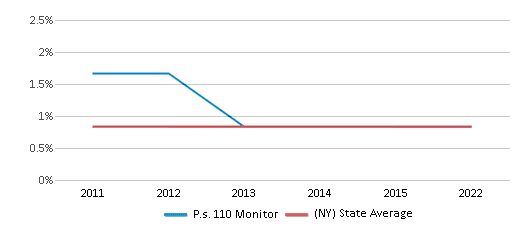
Asian
3%
10%
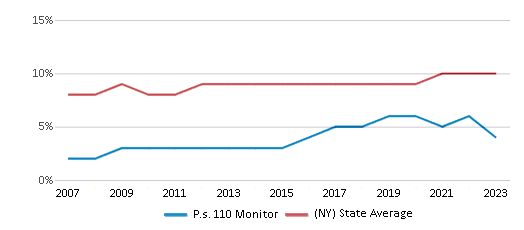
Hispanic
20%
30%

Black
3%
16%
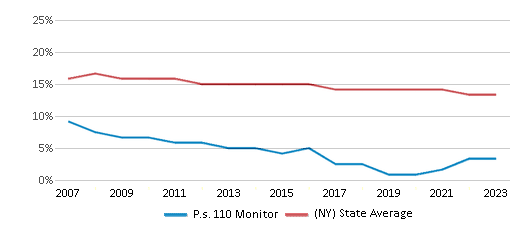
White
64%
40%
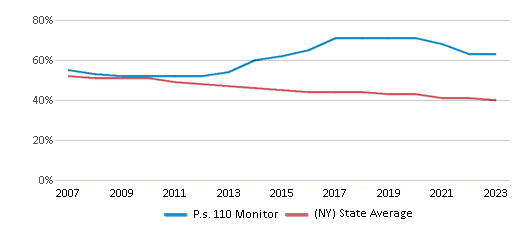
Hawaiian
n/a
n/a
Two or more races
10%
3%
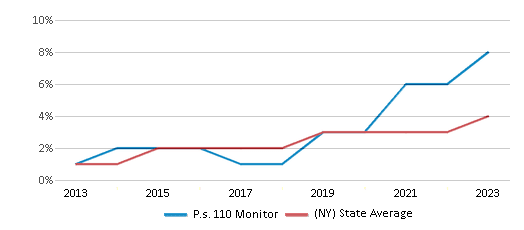
All Ethnic Groups
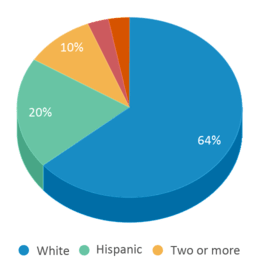
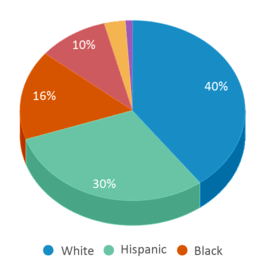
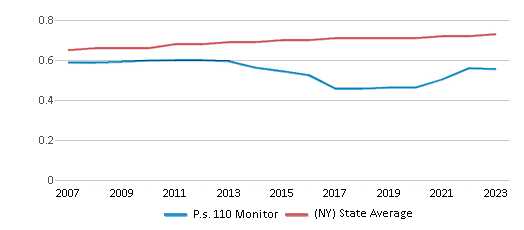
Participates in the National School Lunch Program (NSLP)
Yes
Eligible for Free Lunch
22%
54%
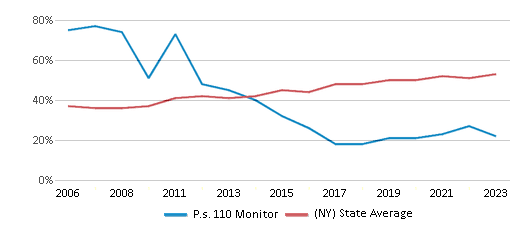
Eligible for Reduced Lunch
2%
3%
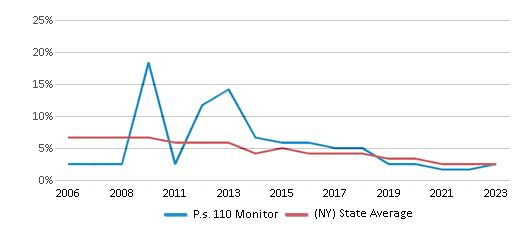
School Statewide Testing
School District Name
Source: National Center for Education Statistics (NCES), NY Dept. of Education
Profile last updated: 02/09/2025
Frequently Asked Questions
What is P.s. 110 Monitor's ranking?
P.s. 110 Monitor is ranked #1642 out of 4,377 schools, which ranks it among the top 50% of public schools in New York.
What schools are P.s. 110 Monitor often compared to?
P.s. 110 Monitoris often viewed alongside schools like P.s. 34 Oliver H Perry, P.s. 31 Samuel F Dupont by visitors of our site.
What percent of students have achieved state testing proficiency in math and reading?
45-49% of students have achieved math proficiency (compared to the 46% NY state average), while 55-59% of students have achieved reading proficiency (compared to the 49% NY state average).
How many students attend P.s. 110 Monitor?
477 students attend P.s. 110 Monitor.
What is the racial composition of the student body?
64% of P.s. 110 Monitor students are White, 20% of students are Hispanic, 10% of students are Two or more races, 3% of students are Asian, and 3% of students are Black.
What is the student:teacher ratio of P.s. 110 Monitor?
P.s. 110 Monitor has a student ration of 16:1, which is higher than the New York state average of 11:1.
What grades does P.s. 110 Monitor offer ?
P.s. 110 Monitor offers enrollment in grades Prekindergarten-5 (offers virtual instruction).
What school district is P.s. 110 Monitor part of?
P.s. 110 Monitor is part of New York City Geographic District #14 School District.
In what neighborhood is P.s. 110 Monitor located?
P.s. 110 Monitor is located in the Greenpoint neighborhood of Brooklyn, NY. There are 2 other public schools located in Greenpoint.
School Reviews
5 9/23/2006
I find P.S. 110 extrodinary. My daughters and I love our teachers very much. All students receive personal attention when needed. The teachers and parents see eye to eye on different issues. Our Principal who just retired Ms. Bednarz was excellent, and she passed her knowledge and high standards onto our new Principal and Asst. Principal who I know are a great asset to our school.
Our children have many different activities, art, music, before and after school program, etc.
Working parents have an option of leaving their children at school for brakfast at 7:40 where they are supervised till class starts. Lunch is also served by our well trained staff who strives for the best, healthy food, no junk.
Ms. Atson is always promoting new ideas as the parent/teacher coordinator to get as many parents as possible to participate in the different projects, and work shops she organizes, that includes translating everything that goes out on flyers into Spanish and Polish.
I Salute P.S.110.
Renata Pirro
Review P.s. 110 Monitor. Reviews should be a few sentences in length. Please include any comments on:
- Quality of academic programs, teachers, and facilities
- Availability of music, art, sports and other extracurricular activities
Recent Articles

What Is A Charter School?
Explore the world of charter schools in this comprehensive guide. Learn about their history, how they operate, and the pros and cons of this educational innovation. Discover key facts about charter schools, including admission policies, demographics, and funding, as well as what to look for when considering a charter school for your child.

10 Reasons Why High School Sports Benefit Students
Discover the 10 compelling reasons why high school sports are beneficial for students. This comprehensive article explores how athletics enhance academic performance, foster personal growth, and develop crucial life skills. From improved fitness and time management to leadership development and community representation, learn why participating in high school sports can be a game-changer for students' overall success and well-being.

February 05, 2025
Understanding the U.S. Department of Education: Structure, Impact, and EvolutionWe explore how the Department of Education shapes American education, from its cabinet-level leadership to its impact on millions of students, written for general audiences seeking clarity on this vital institution.





